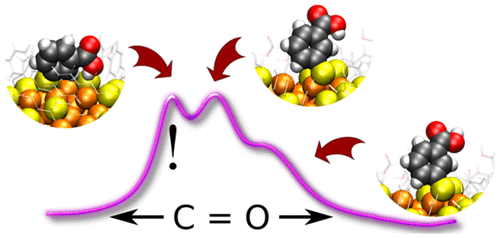Our official English website, www.x-mol.net, welcomes your
feedback! (Note: you will need to create a separate account there.)
Dynamic Stabilization of the Ligand–Metal Interface in Atomically Precise Gold Nanoclusters Au68 and Au144 Protected by meta-Mercaptobenzoic Acid
ACS Nano ( IF 15.8 ) Pub Date : 2017-11-21 00:00:00 , DOI: 10.1021/acsnano.7b07787 Tiia-Riikka Tero 1 , Sami Malola 2 , Benedek Koncz 1 , Emmi Pohjolainen 2 , Saara Lautala 2 , Satu Mustalahti 1 , Perttu Permi 1, 3 , Gerrit Groenhof 1 , Mika Pettersson 1 , Hannu Häkkinen 1, 2
ACS Nano ( IF 15.8 ) Pub Date : 2017-11-21 00:00:00 , DOI: 10.1021/acsnano.7b07787 Tiia-Riikka Tero 1 , Sami Malola 2 , Benedek Koncz 1 , Emmi Pohjolainen 2 , Saara Lautala 2 , Satu Mustalahti 1 , Perttu Permi 1, 3 , Gerrit Groenhof 1 , Mika Pettersson 1 , Hannu Häkkinen 1, 2
Affiliation

|
Ligand-stabilized, atomically precise gold nanoclusters with a metal core of a uniform size of just 1–3 nm constitute an interesting class of nanomaterials with versatile possibilities for applications due to their size-dependent properties and modifiable ligand layers. The key to extending the usability of the clusters in applications is to understand the chemical bonding in the ligand layer as a function of cluster size and ligand structure. Previously, it has been shown that monodispersed gold nanoclusters, stabilized by meta-mercaptobenzoic acid (m-MBA or 3-MBA) ligands and with sizes of 68–144 gold atoms, show ambient stability. Here we show that a combination of nuclear magnetic resonance spectroscopy, UV–vis absorption, infrared spectroscopy, molecular dynamics simulations, and density functional theory calculations reveals a distinct chemistry in the ligand layer, absent in other known thiol-stabilized gold nanoclusters. Our results imply a low-symmetry C1 ligand layer of 3-MBA around the gold core of Au68 and Au144 and suggest that 3-MBA protects the metal core not only by the covalent S–Au bond formation but also via weak π–Au and O═C–OH···Au interactions. The π–Au and −OH···Au interactions have a strength of the order of a hydrogen bond and thus are dynamic in water at ambient temperature. The −OH···Au interaction was identified by a distinct carbonyl stretch frequency that is distinct for 3-MBA-protected gold clusters, but is missing in the previously studied Au102(p-MBA)44 cluster. These thiol–gold interactions can be used to explain a remarkably low ligand density on the surface of the metal core of these clusters. Our results lay a foundation to understand functionalization of atomically precise ligand-stabilized gold nanoclusters via a route where weak ligand–metal interfacial interactions are sacrificed for covalent bonding.
中文翻译:

偏巯基苯甲酸保护的原子精确金纳米簇Au 68和Au 144中配体-金属界面的动态稳定
配体稳定的原子精确的金纳米簇,其金属核的均匀尺寸仅为1-3 nm,构成了一类有趣的纳米材料,由于它们的尺寸依赖性和可调节的配体层,具有广泛的应用前景。扩展簇在应用中的可用性的关键是了解配体层中的化学键与簇大小和配体结构的关系。以前,已有研究表明,通过间巯基苯甲酸(m-MBA或3-MBA)配体,金原子大小为68–144,显示出环境稳定性。在这里,我们证明了核磁共振波谱,紫外可见吸收,红外波谱,分子动力学模拟和密度泛函理论计算的组合揭示了配体层中独特的化学性质,而在其他已知的硫醇稳定化的金纳米簇中却没有。我们的结果表明,在Au 68和Au 144的金核周围存在3-MBA的低对称C 1配体层,这表明3-MBA不仅通过共价S-Au键的形成而且还通过S-Au键的形成来保护金属核。π-Au和O═C-OH··Au相互作用弱。π-Au和-OH···Au相互作用的强度约为氢键,因此在环境温度下在水中是动态的。-OH···Au相互作用通过3-羰基保护的金团簇中不同的羰基拉伸频率来识别,但先前研究的Au 102(p -MBA)44团簇中却不存在。这些硫醇-金的相互作用可以用来解释这些簇的金属核表面上的配体密度非常低。我们的研究结果为了解通过精确的配体与金属间的弱相互作用而牺牲共价键合的途径来了解原子精确配体稳定的金纳米团簇的功能奠定了基础。
更新日期:2017-11-21
中文翻译:

偏巯基苯甲酸保护的原子精确金纳米簇Au 68和Au 144中配体-金属界面的动态稳定
配体稳定的原子精确的金纳米簇,其金属核的均匀尺寸仅为1-3 nm,构成了一类有趣的纳米材料,由于它们的尺寸依赖性和可调节的配体层,具有广泛的应用前景。扩展簇在应用中的可用性的关键是了解配体层中的化学键与簇大小和配体结构的关系。以前,已有研究表明,通过间巯基苯甲酸(m-MBA或3-MBA)配体,金原子大小为68–144,显示出环境稳定性。在这里,我们证明了核磁共振波谱,紫外可见吸收,红外波谱,分子动力学模拟和密度泛函理论计算的组合揭示了配体层中独特的化学性质,而在其他已知的硫醇稳定化的金纳米簇中却没有。我们的结果表明,在Au 68和Au 144的金核周围存在3-MBA的低对称C 1配体层,这表明3-MBA不仅通过共价S-Au键的形成而且还通过S-Au键的形成来保护金属核。π-Au和O═C-OH··Au相互作用弱。π-Au和-OH···Au相互作用的强度约为氢键,因此在环境温度下在水中是动态的。-OH···Au相互作用通过3-羰基保护的金团簇中不同的羰基拉伸频率来识别,但先前研究的Au 102(p -MBA)44团簇中却不存在。这些硫醇-金的相互作用可以用来解释这些簇的金属核表面上的配体密度非常低。我们的研究结果为了解通过精确的配体与金属间的弱相互作用而牺牲共价键合的途径来了解原子精确配体稳定的金纳米团簇的功能奠定了基础。











































 京公网安备 11010802027423号
京公网安备 11010802027423号